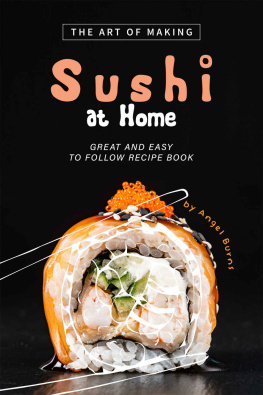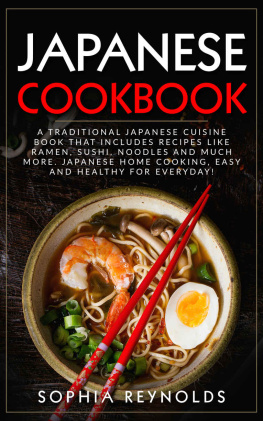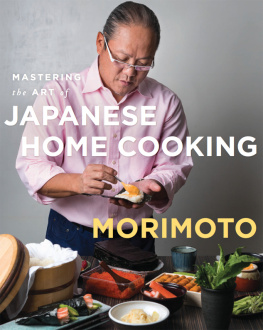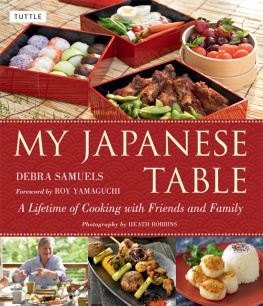Japanese Cookbook for Everyday Cooking
Easy & Healthy Japanese Recipes to Cook at Home
BY: SOPHIA FREEMAN
2020 Sophia Freeman All Rights Reserved
Liability
This publication is meant as an informational tool. The individual purchaser accepts all liability if damages occur because of following the directions or guidelines set out in this publication. The Author bears no responsibility for reparations caused by the misuse or misinterpretation of the content.
Copyright
The content of this publication is solely for entertainment purposes and is meant to be purchased by one individual. Permission is not given to any individual who copies, sells or distributes parts or the whole of this publication unless it is explicitly given by the Author in writing.
My gift to you!
Thank you, cherished reader, for purchasing my book and taking the time to read it. As a special reward for your decision, I would like to offer a gift of free and discounted books directly to your inbox. All you need to do is fill in the box below with your email address and name to start getting amazing offers in the comfort of your own home. You will never miss an offer because a reminder will be sent to you. Never miss a deal and get great deals without having to leave the house! Subscribe now and start saving!
Table of Contents
Introduction
One way to get to know a country or culture better is to experience its local cuisine.
The traditional Japanese cuisine, also known as washoku, is recognized by the UNESCO as an Intangible Cultural Heritage.
The countrys diverse influences from neighboring countries have resulted in an interesting collection of food that, although evolved, did not lose touch with tradition.
From the way it carefully presents its food down to the mastery that goes into the preparation, Japans high regard for quality and excellence is manifest.
An impressive facet of Japanese food is presentation.
Have you seen their bento lunch boxes?
The essence lies in the use of high-quality and fresh ingredients that are in season.
Pair them with meticulous preparation and attention to detail, and you will get the true Japanese cuisine.
The island country of Japan prides itself for its fresh fish and seafood offerings.
Sushi is indeed one of the well-known Japanese dishes made with rice and slices of raw fish or shellfish dipped in soy sauce with wasabi.
Sashimi is thin, bite-sized slices of raw fish, typically tuna or salmon, and eaten with soy sauce.
Tempura is fish, seafood, meat, or vegetable that is coated with batter and is deep-fried to perfection. It goes well with a dipping sauce called tentsuyu.
Sukiyaki is a beloved soup dish cooked in a shallow cast-iron pot. It has beef, vegetables, and tofu that are simmered in a soy broth.
These are literally only a few of the many fascinating and must-try Japanese foods.
Excited to prepare these amazing dishes in your own kitchen?
Then, lets get started.
Additional Interesting & Useful Information
Japanese food is certainly among the healthiest in the world. Its food includes lots of fresh seafood and vegetables. Just look at the Japaneses impressive average life expectancy.
Its cuisine consists primarily of seafood and rice. Eating meat is quite recent as it was only introduced during the mid-19th century when Japan adapted Westernization after the 214 years of sakoku (closed country).
Japan has the most Michelin-starred restaurants in the world in 2019, beating Paris.
Japanese cuisine is the third most loved in the world next to Italian and Chinese.
People follow food etiquettes in Japan. For example, it is perfectly fine if you make slurping sounds when eating noodles, but you should never do this when, indeed, the soup is made with rice. Similarly, you must never stick your chopsticks upright into your rice bowl as it is considered rude.
Omuraisu
Also called omu-rice, omuraisu is a type of omelet thats stuffed with fried rice and drizzled with ketchup.
Serving Size: 2
Preparation Cooking Time: 20 minutes
Ingredients:
Cooking spray
2 slices ham, sliced into small cubes
2 cups cooked white rice
1 slice cheese, chopped
3 tablespoons ketchup, divided
2 eggs
Salt and pepper to taste
teaspoon fresh parsley, chopped
Instructions:
1. Spray your pan with oil.
2. Add the ham, cooked rice, cheese and 2 tablespoons ketchup.
3. Cook while stirring approximately for 8 to 10 minutes.
4. Transfer the rice mixture to a plate.
5. Form an oval shape from the mixture.
6. Beat the eggs in a bowl.
7. Season with the salt and pepper.
8. Cook the eggs in the same pan.
9. Transfer the eggs on top of the oval-shaped rice mixture.
10. Tuck the edges underneath the rice to form a cocoon.
11. Make some slices on top of the egg.
12. Drizzle with the ketchup.
13. Sprinkle the parsley on top.
Nutrients per Serving:
Calories: 521.4
Fat: 20.2 g
Saturated Fat: 8.6 g
Carbohydrates: 59.3 g
Fiber: 0.8 g
Protein: 26.7 g
Cholesterol: 403.2 mg
Sugars: 12.4 g
Sodium: 1299.9 mg
Potassium: 511.6 mg
Okonomiyaki
Okonomiyaki is indeed a type of Japanese pancake thats savory instead of sweet. It is a popular street food in Osaka, Japan. It is made with eggs, flour, cabbage, other vegetables and meat. In this recipe, we make this pancake with bacon, sausage, shrimp and cheese.
Serving Size: 40
Preparation Cooking Time: 4 minutes
Ingredients:




![Freeman - Pro design patterns in Swift: [learn how to apply classic design patterns to iOS app development using Swift]](/uploads/posts/book/201359/thumbs/freeman-pro-design-patterns-in-swift-learn-how.jpg)














